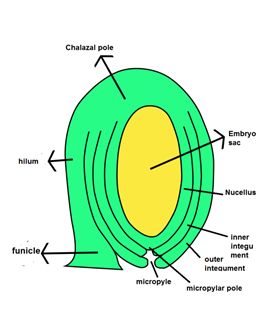With a neat, labelled diagram, describe the parts of a typical angiosperm ovule.

1. Funicle – The ovule is a small structure attached to the placenta by means of a stalk called funicle.
2. Hilum – It is the junction between ovule and funicle. The body of the ovule fuses with funicle in the region called hilum.
3. Integument - These are the protective envelops of ovule. There are two integuments, one is outer and the other is inner.
4. Nucellus – Enclosed within integuments is a mass of cells called the nucellus. The cells of nucellus have abundant reserve food materials.
5. Embryo sac – An ovule has one embryo sac formed from a megaspore. It is located in the nucellus. It is the site of fertilization of egg and development of embryo.
6. Micropyle – Integuments encircle the nucellus except at the tip where a small opening is organized. This small opening is known as Micropyle.
7. Chalaza – Opposite the micropylar end, the swollen basal part of the ovule is represented by the chalaza.